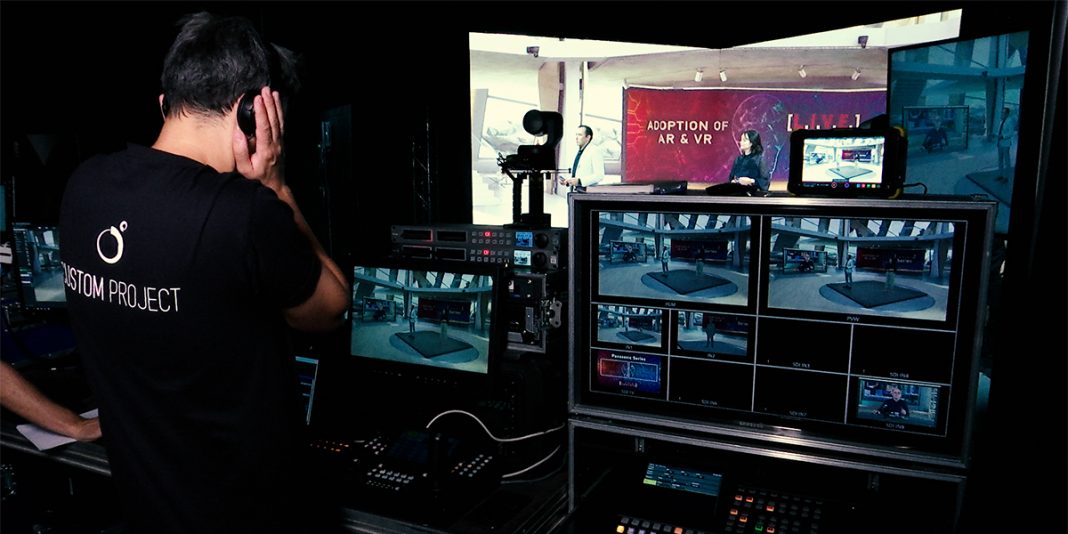Set out at as a five-episode run of tutorials, Panasonic’s L.I.V.E (Live Integrated Video Experience) Series was launched in the last quarter of 2020 with the goal of providing customers with an insight into the ever-expanding virtual studio sector. Collaborating with a number of studios, including Creative Technology’s London facility and CustomProject’s Barcelona location, the Panasonic team hopes to provide viewers a glimpse into the future of virtual events and the technology behind such developments as AR, XR, robotic cameras and much more.
Speaking to TPi, Panasonic’s Guilhem Krier, Manager of Product Marketing and Business Development, described the origins of the project. “Due to the current global situation, we were unable to get in touch with our customers through face-to-face interaction, events and exhibitions, meaning that we needed to find a new way to keep our customers informed about our new products, technology, and our direction,” he began.
Although webinars on consumer platforms such as Zoom were considered initially, Krier and the rest of the Panasonic team felt this would not satisfy the needs of its customers. “We did not feel that simply hosting a webinar was good enough to convey our message properly,” he stated simply. “We have also found that our customers are, to some extent, expecting greater levels of production value when watching online content.”
This led to the team deciding to create a full video production and, with such a vast array of content to cover, they opted to create a five-part series, with each video focusing on a different subject. These include: an introduction to xR Studios; trends to watch out for in the broadcast sector; robotic camera systems; new workflows for video production; and an introduction to Panasonic’s Smart Live Production concept.
Although each episode covers a different subject matter, all five of them are centred around recurring themes – the usage of virtual studios, automated production, and the transition to IP. “We picked these themes because they are current market trends, all of which have been accelerated as a result of the impact from social distancing measures implemented globally. They also match with the concept of our Smart Live Production portfolio,” commented Krier.
From the beginning, Krier commented that to truly demonstrate the end-to-end solution that the company offered, it only made sense to partner with companies that already had studios up and running that were powered with Panasonic technology. “This led us to collaborate with Creative Technology, which are readily using our system cameras and PTZ cameras, and also had Kairos – our next-generation IP-based video processing platform – already installed within its xR studio,” stated Krier. “The same went for CustomProject, which makes use of the AW-UE150 4K PTZ camera and the Tuning rail system installed in its studio.”
Having worked with Panasonic for a long time, Creative Technology’s Head of Vision and Integrated Networks, Sid Lobb was keen to praise the company’s latest product releases. “We were given the opportunity by Panasonic to start some beta testing of Kairos prior to its release,” he commented.
Lobb recalled the “fortuitous” timing of having the Kairos due to the increase in virtual events that arrived in March. “The removal of the hardware limitations that Kairos brings, particularly in the number of PIPs and native IP inputs, enabled us to facilitate Zoom-style gallery calls within a Broadcast environment for one show, and turn around very quickly to mix a more traditional show but within an xR studio – flexibility that would have been extremely difficult for a traditional vision mixer,” he added. “We really value our relationship with Panasonic and their reaching out to us at that time was key in helping us develop our strategy for dealing with the impact of COVID-19.”
Krier revealed that the recent surge in interest in virtual events “hasn’t really changed” Panasonic’s marketing plan. “This trend was already detected, and we’ve been working on solutions for virtual studios for a long time.” He added that this trend had very much been built into the fabric of Panasonic’s wider product portfolio so as to work seamlessly with PTZ and system cameras, robotic solutions, tracking systems and now Kairos, the company’s IT/IP video processing platform.
“One point that is also important to mention is that the solutions that Panasonic offers to the market have to be affordable and simple to use,” he mused. “Production budgets are tighter, so providing high-quality and high-value technology is important, but it has to fit into today’s budget requirements. Our PTZ and robotic systems offer the best value for the money, allowing customers to get much more camera angles than before.”
Krier concluded by giving his final thoughts on how he believed the interest in virtual events will manifest as we move into 2021. “We believe that going forward we’ll see a hybrid of both physical and virtual events,” he stated. “Virtual cannot replace some live events but provide an opportunity to watch content on demand easily. It also gives opportunity for a potential global rather than national audience, and so we definitely expect them to stay in 2021.” The entire series of videos is still available to watch online here.
This article originally appeared in issue #257 of TPi, which you can read here.






